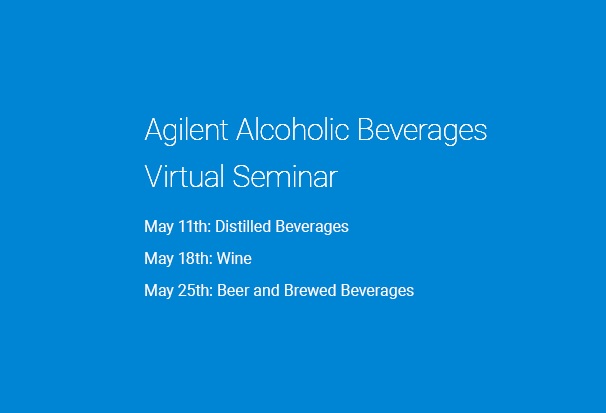Alcoholic Beverages Virtual Seminar - Beer and Brewed Beverages

Agilent Technologies: Alcoholic Beverages Virtual Seminar
Sharing the latest in Agilent's latest technology developments and capabilities, new applications and some customer stories.
Topics include safety, taste profiling, quality and general safety of raw materials and final products.
The meeting is a mix of live presentations and on-demand content you can join and view, wherever you are and whenever you can.
An Overview of Beer Chemistry and the Analysis of Yeast Metabolites and Fermentation Byproducts by HS-GC-μECD and HS-SPME-GC-MS
Speaker: Carly Mondek (New Belgium, USA)
Abstract: The brewing process and specific beer style produced hinges on four main traditional ingredients: water, malt, hops, and yeast. The amount, type, and method in which these raw materials are combined create unique and defined flavor attributes that contribute to the overall profile of a beer. To successfully produce a consistent quality product, analytical tests and analyses are implemented throughout each stage of the brewing process. Vicinal Diketones (VDKs) and yeast volatile metabolites, such as aldehydes, esters, and alcohols, are critical components in determining fermentation health, completion, and yeast performance, as well as establishing a flavor profile. Headspace Gas Chromatography paired with Micro-electron Capture Detection (HS-GC-μECD) was used to quantify the production of VDKs while Headspace Solid Phase Microextraction Gas Chromatography-Mass Spectrometry (HS-SPME-GC-MS) analysis measured selected volatile compounds throughout fermentation. Comparative analysis was performed to determine the effects of varying fermentation parameters in different beer styles on the concentration of yeast metabolites and fermentation byproducts.
An Undergraduate Research Project using HS-SPME-GC-MS: How Apple Variety, Yeast Strain, and Dry Hopping Shape the Aroma of Cider
Speaker: Callie Cole (Fort Lewis College, USA)
Abstract: Headspace Solid Phase Microextraction Gas Chromatography Mass Spectrometry (HS-SPME-GC-MS) Analysis has been previously employed as an efficient and robust method for the detection of trace analytes in a wide variety of foods and beverages. However, the many variables that influence the volatile organic compounds (VOCs) released by cider beverages remain to be thoroughly examined. These include apple variety, yeast strain, and maturation techniques such as dry hopping. Undergraduate research students at Fort Lewis College have collaborated with local orchards and cideries in Montezuma County Colorado to prepare ciders controlling for and sequentially altering all of these variables to better understand their impact on final cider quality. Our HS-SPME-GC-MS analyses of these ciders reveal the specific esters, higher alcohols, and terpenes that comprise cider aroma.
On-demand presentation available from 25 May 2021
The Good and the Bad Influence of Polyfunctional Thiols in Beer Hops; Is it Grapefruit or a Cat Box?
Speaker: Matthew Curtis, Ph.D (Agilent GC/MS Applications Scientist, Santa Clara, CA, USA)
Abstract: This presentation will discuss the analysis of beer hop fragrance using low energy electron ionization (EI) to identify low level polyfunctional thiols. Thiols are normally perceived as an off odor or undesirable characteristic, but in the right concentration positive perceived aroma can be achieved. Several beer hops were analyzed in two different forms: whole cone and pellets, to correlate any difference of the volatile compounds if the processing of the hop can change the composition. The ability to ionize and detect these low-level compounds and how the increased degrees of confirmation can provide higher confidence in these identifications. The low energy EI, high resolving power, and data analysis tools provided high confidence in the finding the compounds as well as identifications.